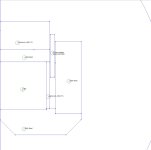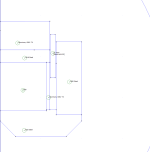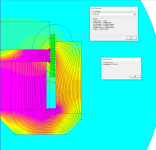Good, now make the entire depth of the enclosure and driver under 10".
The compliance of loudspeaker suspension changes throughout the range of motion.This could be then thought as if the good driver was bad because it sounds different on low and high power, while the bad driver sounds good on both. This explanation is more logical to me, than somehow having non-linear effects appear on low power which is exactly opposite how other driver non-linearities work, they get worse with more power (excursion).
https://www.klippel.de/fileadmin/kl...urement of Loudspeaker Suspension_Klippel.pdf
The effect varies with driver size and suspension types, but in addition to our hearing's "equal loudness contours" which differ from person to person, the difference in driver response at different levels can be quite apparent.
Music with greater low frequency dynamics, (such as orchestral compositions) make the suspension non-linearities more obvious than more compressed music genres.
Tricky with an 18" driver - even more so with the 21s I'm building!Good, now make the entire depth of the enclosure and driver under 10".
Yes.Why is the coil heating, is this I2R loss?
Yes, but thicker wire puts less wire in the gap, reducing Bl.1 - Would coils made with much thicker wire have less resistance and heat up less for the same current flow?
Silver wire could reduce I2R losses by ~5% at low drive levels, but weighs considerably more, resistance increases more with temperature than copper, costs ~7 times more, and is harder to work with, making coil production more difficult. Break a wire while winding, and you have silver scrap.2 - Silver wire coils? Savings on cone tech with a simple aluminium cone might allow funds for silver wire?
Aluminum voice coil properties can be better than copper, but also is considerably more difficult to work, driving cost up.
The only Mackie I owned was a HRS120 sub with a 12" driver and passive radiator, it looked pretty plain.That gorgeous Mackie of yours with the RCF driver (hey, I asked you if you knew which driver). Any guesstimates how much more that driver would cost if it had silver coils?
I never pulled the drivers, don't know the OEM manufacturer.
As a wild guess, if the copper coil cost $60 at retail, a silver one would cost over $400.
The only manufacture I'm aware of using (optional) silver voice coils is Lowther, but the weight of their tiny voice coils is only a few grams.
Art
Assuming you keep the same number of layers on the VC, thicker wire will always make more BL. Even if you have to increase the gap width to accommodate the thicker wire. Also, aluminum coils are no different to wind than copper. Silver sounds like a nightmare, though.
This is a good thing to confirm. One day there will be DIY attemptsAssuming you keep the same number of layers on the VC, thicker wire will always make more BL. Even if you have to increase the gap width to accommodate the thicker wire. Also, aluminum coils are no different to wind than copper. Silver sounds like a nightmare, though.
To illustrate, I drew up a basic cup motor with a 23awg copper 4 layer coil and then increased the wire size to 22awg copper 4 layer coil with widening the gap to take up the extra width. The BL^2/Re motor force is 93.4 for the motor with the 23awg coil and 103.7 for the same motor with a 22awg coil, even though the BL itself is lower on the 22awg coil motor its motor force is still higher.
Attachments
Sorry one more off-topic post but thought to post for completeness.
Quickly on the 'wake up' phenomenon: another aspect that might contribute to perceived difference in low or high power, that I never thought of before, could be the enclosure and namely how reflex port is implemented.
Ported system performance heavily depends on the port, as per "Maximizing Performance from Loudspeaker Ports" paper for example tuning frequency could change with SPL due to turbulence in the port. For example, if some PA driver was utilized in home speaker on relatively small box it likely has small port as well, than same driver in a PA system big box with port for high SPL use. Both might give different impression even if it was the same driver, even in similar box but just by difference how the port was implemented. Even the heat buildup is affected by port implementation. Very interesting stuff, woofers and boxes are far more complicated than plotting some graphs with WinISD let's believe 😀
ps. thanks Art for the suspension paper, didn't get to read it yet!
Quickly on the 'wake up' phenomenon: another aspect that might contribute to perceived difference in low or high power, that I never thought of before, could be the enclosure and namely how reflex port is implemented.
Ported system performance heavily depends on the port, as per "Maximizing Performance from Loudspeaker Ports" paper for example tuning frequency could change with SPL due to turbulence in the port. For example, if some PA driver was utilized in home speaker on relatively small box it likely has small port as well, than same driver in a PA system big box with port for high SPL use. Both might give different impression even if it was the same driver, even in similar box but just by difference how the port was implemented. Even the heat buildup is affected by port implementation. Very interesting stuff, woofers and boxes are far more complicated than plotting some graphs with WinISD let's believe 😀
ps. thanks Art for the suspension paper, didn't get to read it yet!
Last edited:
Yes.
Yes, but thicker wire puts less wire in the gap, reducing Bl.
Silver wire could reduce I2R losses by ~5% at low drive levels, but weighs considerably more, resistance increases more with temperature than copper, costs ~7 times more, and is harder to work with, making coil production more difficult. Break a wire while winding, and you have silver scrap.
Aluminum voice coil properties can be better than copper, but also is considerably more difficult to work, driving cost up.
The only Mackie I owned was a HRS120 sub with a 12" driver and passive radiator, it looked pretty plain.
I never pulled the drivers, don't know the OEM manufacturer.
As a wild guess, if the copper coil cost $60 at retail, a silver one would cost over $400.
The only manufacture I'm aware of using (optional) silver voice coils is Lowther, but the weight of their tiny voice coils is only a few grams.
Art
Assuming you keep the same number of layers on the VC, thicker wire will always make more BL. Even if you have to increase the gap width to accommodate the thicker wire. Also, aluminum coils are no different to wind than copper. Silver sounds like a nightmare, though.
This is a good thing to confirm. One day there will be DIY attempts
https://www.anixter.com/en_au/resources/literature/wire-wisdom/conductor-resistance.html
Usually I can connect the hip bone to the neck bone at lightning speed, but this time I was slow. No need for DIY attempts. It's been done already maybe at massive scale and scope. How much less resistance does silver have over copper? I dont know how to add it up but let's say our copper voice was 8R and our silver one was 8R, wouldn't they both dissipate the same watts in heat?
Maybe car audio solves this by even budget and no name brand amps now built stiffened to run down to 1R as seen on the amp dyno channels. Take the 12" ZXI12.2D 1000w driver. This is supposed to be from the SQ series. Coils in parallel will be 1R and how much more would this heat up as opposed to an 8R 1000w PA driver? My takeaway, along with a big motor, dense cone, super excursion but GT3 spec dampening, a super low resistance voice coil too. Four 1R subs in series would be a comfy 8R load for an amp and more output than a single 8R driver on the same amp
You can parallel up drivers to get lower system impedance but if PA changed over to pro mobile type drivers and allowed mostly 1R coils, drivers heating up would be less of a problem
@hurrication and others, any suggestions for publicly available 15 inch drivers that have these small box friendly attributes? is your driver, after release, going to be available for general public?
About 5%.How much less resistance does silver have over copper?
The silver wire weighs about 15% more than copper of the same diameter.I dont know how to add it up but let's say our copper voice was 8R and our silver one was 8R, wouldn't they both dissipate the same watts in heat?
Weight reduces efficiency, making more heat vs SPL.
The silver coil would cost ~7times more, and probably would reduce thermal efficiency slightly.
You would need to compare specific drivers to determine which is more efficient for a given SPL level.Take the 12" ZXI12.2D 1000w driver. This is supposed to be from the SQ series. Coils in parallel will be 1R and how much more would this heat up as opposed to an 8R 1000w PA driver?
In general, given the same motor strength, the extra diaphragm and coil weight required for a high power, high excursion driver reduces it's efficiency compared to drivers using lighter components.
The more efficient driver/enclosure would create less heat.
The driver's efficiency varies with frequency.
Larger Sd and cabinet size will increase efficiency.
Four 1ohm subs in series is 4 ohms, not 8.Four 1R subs in series would be a comfy 8R load for an amp and more output than a single 8R driver on the same amp
Amplifiers can be made to be "comfy" driving virtually any impedance.
Powersoft makes amps capable of providing ~15,000watts (15kW) into their 20kW peak M-force driver nominal impedance of 0.7ohms (Re 0.26 Ω).
Self powered (amplifiers built in to the cabinet) PA subs using 1 ohm voice coils are fairly common, JBL has several drivers in that impedance range used in their subs.You can parallel up drivers to get lower system impedance but if PA changed over to pro mobile type drivers and allowed mostly 1R coils, drivers heating up would be less of a problem
For subs located at a distance from the amplification, higher impedance reduces the cable cost and weight which would be impractical with impedance dropping below ~4ohms.
The efficiency of drivers does not change much with nominal impedance, there is hardly any difference in voice coil heating for the same power level.
The B&C 18SW115 (and many other drivers) are available in 8ohm and 4ohm versions, the 8ohm version is slightly more sensitive than the 4ohm version, it would heat up slightly less.
The Stereo Integrity SQL 15 is a good one that I can think of off the top of my head. I plan on making and selling my drivers after all the patents have been filed and there is a licensing agreement to suit.@hurrication and others, any suggestions for publicly available 15 inch drivers that have these small box friendly attributes? is your driver, after release, going to be available for general public?
The spec sheets show the B&C18SW115-4 has BL (26.07 TXM) and flux density(1.15T)The 18SW115_4 has more motor force.
The 18SW115-8 has BL (30.3 TXM) and flux density(1.16T), more motor force.
The 18SW115-8 magnetic gap is shorter, 12mm compared to 14mm for the 18SW115-4.
Same 34mm winding depth, yet Xmax and Xvar are rated the same, 14&16mm.
Given the same voltage input, the 18SW115-4 would draw almost twice the power, most of which is converted to heat.It would heat up less for the same input.
The sensitivity 1W/1m sensitivity of the 18SW115-4 is rated at 96dB, the 18SW115-8 97dB, though most of the sensitivity increase is above 200Hz.
Although everything from the specs (other than the shorter gap..) would indicate the 18SW115-8 would heat up less, I have never compared the heat of the two drivers at the same SPL in the same cabinet design.
Have you?
Art
While generally true, but weight to an extant is also required to drive the small box. The pro mobile drivers are designed for small boxes to fit in cars. JBL has been in the mobile audio game long enough to watch the pro mobile subs evolve and use those methods in other areas. They were late at offering pro mobile units and the products were actually more pro consumerWeight reduces efficiency, making more heat vs SPL
1R copper voice coils sounds like substantial rewards for a cooler driver ina small box, I might explore this with a 4 driver array with each driver at 1R and all in series. If each cab is 1R Re and 90dB with 1w at 1m, does that mean the 4 cabs in series make for 99dB for the array for 1w at 1m?
For me, this would be massive cost and space savings as the pro mobile array at 99dB with 1w will cost much less in cab material as those 4 cabs will take up less space than half a single PA cab. On top of that, you guys have pointed out that with the available excursion and control in the pro mobile driver, they might actually have a greater ability to produce more low frequency energy when given full power
This goes to throw my plans for using PA 18s ina mess. Adding a ZXI at a time as budget allows makes for 8x 30L cabs under my bench and seem to allow more choices than a pair of 400L PA bins
Amazing to see all my questions and points and explorations over the past few months is not isolated to my unique case. So many new threads on these matters by folks coming out of the wood work on this. So many almost repeated phrases of my findings in sims and such in these threads and even folks now suggesting exploring pro mobile subs to new inquiries re small cabs
This change is very noticeable in the forum as a direct result of my recent obsessions 😀
A supercharged mini sub PA array of ZXIs seems quite formidable as a PA system for music with a lot of LF energy
Maybe this 15"@hurrication and others, any suggestions for publicly available 15 inch drivers that have these small box friendly attributes? is your driver, after release, going to be available for general public?
https://ds18.com/collections/15-sub...fer-2000-watts-4-ohm-dvc-quad-stacked-magnets
Their recommendation for 2cf sealed on that one is right around the lower limit I'd use with them.
not to hate on the driver, but 63 mH inductance? Isn't that 10x a typical driver? I'm not a pro, so my knowledge is basic that high inductance means more distortion as power rises, without knowing the mechanism.
- Home
- Loudspeakers
- Subwoofers
- Driver characteristics for small enclosures?



